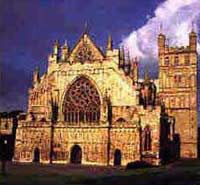|
Exeter in
Devon
|
 A Roman city founded in the first century AD, Exeter is the historical capital of Southwest England. Much of the old city was destroyed during WWII bombings, but many of the ancient landmarks still remain. Exeter Cathedral was established in 1050, but has been rebuilt many times since. Its most notable feature is its twin Norman towers. A 300-foot long Gothic vault, the longest unbroken stretch of tierceron vaulting in the world, lies between the towers. Also at the cathedral are the bishop's throne, the minstrels' gallery and the cathedral library where the Exeter Book containing Anglo-Saxon poetry is kept. The Green outside the cathedral is a popular spot for picnic lunches during the summer months and provides a panoramic view of the ancient buildings which surround the Cathedral.
A Roman city founded in the first century AD, Exeter is the historical capital of Southwest England. Much of the old city was destroyed during WWII bombings, but many of the ancient landmarks still remain. Exeter Cathedral was established in 1050, but has been rebuilt many times since. Its most notable feature is its twin Norman towers. A 300-foot long Gothic vault, the longest unbroken stretch of tierceron vaulting in the world, lies between the towers. Also at the cathedral are the bishop's throne, the minstrels' gallery and the cathedral library where the Exeter Book containing Anglo-Saxon poetry is kept. The Green outside the cathedral is a popular spot for picnic lunches during the summer months and provides a panoramic view of the ancient buildings which surround the Cathedral.
Thought to be one of the oldest municipal buildings in the area, the Exeter Guildhall was built in the fifteenth century and contains collections of silver and paintings including one of Henrietta Anne the daughter of Charles I.
Underneath the city centre are underground passages which were used in Roman times as a means of distributing clean water within the City Walls. Guided tours are available of the passages through the booking office at the top end of the High Street in the alleyway beside Boots.
Much of the old Roman wall has been preserved and free guided walks are available which start at the Cathedral Green. Details are available from the Tourist Information Office in Paris Street.
Rougemont Gardens are a pleasant escape from the hustle and bustle of the High Street shops and within 2 minutes walk away. There is a Museum of Costume at one edge of the gardens, nearest the library and in the summer open air theatre productions take place at Rougemont Castle.
The Quayside has been restored in recent years and now boasts antique shops, restaurants, bars and water-based leisure activities. It is also the site of most of the nightclubs in Exeter.
|
|